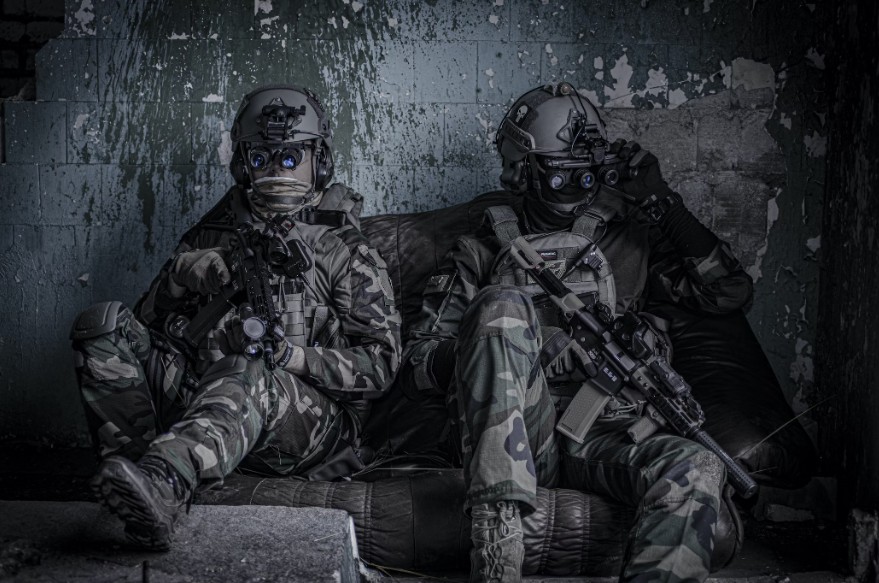Colorblindness is a common condition, affecting 10% of men and 1% of women in the United States. However, you may not realize that colorblind individuals are also able to serve in the military. In fact, many colorblind people have served with distinction as pilots, medics and officers.
Understanding Colorblindness
There are several types of colorblindness, and they can be inherited genetically from either parent. Red-green colorblindness is the most common form, followed by blue-yellow. Total colorblindness is rare, but it can affect any type of color vision.
Colorblindness develops during gestation when the retina lacks cells that sense red light (or green), blue light (or yellow), or both sets of colors together. It’s also possible for people with normal vision to become colorblind after a head injury or stroke affecting their optic nerve or visual cortex areas in their brain responsible for processing what they see into meaningful information like shapes and patterns on objects around them.
About 8 percent of men in America experience some form of difficulty discerning between shades like red versus green; however women only have about 3 percent chance at being affected by this condition.
Colorblindness in the Military
Colorblindness is a disqualifier for the military. While it’s not considered a disability, it can be used as grounds for denying entry into the military or even discharge from service. This is because colorblindness can make it difficult to quickly identify colors and distinguish them from each other at distance or in low light conditions. It also increases your risk of injuring yourself while working around machinery if you cannot tell which colors are safe and which are dangerous–for example, red wires vs black ones (or yellow/green).
In addition to colorblindness being used as justification for denying entry into the armed forces, there may also be times when it’s necessary for someone who has already joined up with us but has since developed this condition later on in their career path due to injury or illness related causes; sometimes those individuals will need additional training before they’re allowed back into active duty status again!
There are a few ways that you can get tested for colorblindness.
One is by using an Ishihara Color Test, which contains a series of images that contain numbers and symbols in different colors. You look at these pictures and try to identify them based on the number/symbol that they contain; if you have trouble doing this, then it’s likely that you’re suffering from some form of red-green colorblindness. There’s also another test calledthe Farnsworth Dichotomous Test where you have to choose between two different colored lights instead of objects like in the Ishihara test–this one is more difficult but also more accurate as far as measuring your level of colorblindness goes.
Military Roles and Challenges

Colorblindness poses challenges for personnel in many military roles. For example, if you are a soldier and your job is to fire weapons, it’s important that you can see the targets clearly and accurately. Colorblindness can make this difficult because some colors like red and yellow look similar when viewed through colorblind eyes. Similarly, if a pilot needs to navigate during flight or work with maps of unfamiliar areas, it could be difficult if they were unable to distinguish between different types of terrain or geographical features such as mountains or rivers–and this may lead them off course unintentionally!
Additionally, medical professionals face challenges when treating patients who suffer from various visual impairments like colorblindness because they might not realize that there are symptoms associated with other conditions besides just being tired (elderly people often complain about feeling tired but aren’t necessarily suffering from fatigue). This means that doctors need extra training so they can identify signs such as double vision caused by diabetic retinopathy which affects approximately 10% – 20% adults over age 65 years old worldwide.
Another example is for someone who has colorblindness, it can be difficult to distinguish between certain colors like red and green. If they are a pilot or medical professional, this may cause them to make mistakes or not see things clearly. For example, if someone with colorblindness is flying an airplane and they need to navigate during flight or work with maps of unfamiliar areas; it could be difficult if they were unable to distinguish between different types of terrain or geographical features such as mountains or rivers–and this may lead them off course unintentionally!
When it comes to colorblindness, there are different types of the condition which may cause someone to be unable to distinguish between certain colors. This is because the cones in the eye that allow us to see color are either missing or deformed; and this causes them not being able to distinguish between certain hues.
Accommodations and Technologies

One of the most common accommodations for colorblind military personnel is software that allows them to see color differences. This type of software works by breaking down the spectrum into different shades, allowing individuals with CVD to distinguish between them.
There are also specialized pieces of equipment that can help those with CVD perform their jobs effectively. For example, some vehicles and aircraft have been equipped with night vision goggles designed specifically for individuals with CVD so they can see better in low-light conditions without affecting other members of their unit or team who don’t have CVDs themselves (and therefore cannot use these devices).
There are also some jobs that cannot be performed by individuals with CVD. These include jobs that require the ability to distinguish color, such as those in the fashion industry or graphic design field. There are also certain military positions where colorblindness can be a hindrance, such as pilots and other aircraft operators who need to see the difference between colors so they can effectively complete their missions.
Success Stories
It’s important to remember that colorblindness is a condition that can be overcome. There are many people with colorblindness who have served in the military and had successful careers, even as officers.
For example:
- Lt. Col. Dave Silverstein has been an Air Force pilot for over 30 years, flying F-15s and F-16s as well as serving as a flight commander at Kadena Air Base in Japan. He was diagnosed with red-green colorblindness while attending pilot training at Vance Air Force Base in Oklahoma City but went on to become one of only two pilots ever selected by their squadron commander for special duty because they were so good at flying planes!
- Major General Darryl Roberson is a retired U.S. Army officer who served in the Persian Gulf War and Operation Iraqi Freedom, where he commanded a brigade of 3,000 soldiers during the Battle of Najaf in 2004. He was diagnosed with red-green colorblindness while in basic training at Fort Benning, Georgia but went on to become one of only two pilots ever selected by their squadron commander for special duty because they were so good at flying planes!
- Colonel Martin Lindstrom is a retired U.S. Air Force officer who flew F-15s and F-16s during his 20 years of service, logging over 2,000 hours in the air. He was diagnosed with red-green colorblindness while attending pilot training at Vance Air Force Base in Oklahoma City but went on to become one of only two pilots ever selected by their squadron commander for special duty because they were so good at flying planes!
- Major General Darryl Roberson is a retired U.S. Army officer who served in the Persian Gulf War and Operation Iraqi Freedom, where he commanded a brigade of 3,000 soldiers during the Battle of Najaf in 2004. He was diagnosed with red-green colorblind while attending pilot training at Vance Air Force Base in Oklahoma City but went on to become one of only two pilots ever selected by their squadron commander for special duty because they were so good at flying planes!
Colorblindness is a common condition but you can still serve in the military.
Colorblindness is a common condition but you can still serve in the military.
It’s important to know that colorblindness cannot be cured, but it can be managed with accommodations and technologies. People who have color vision deficiencies have trouble seeing colors but not all colorblind people have the same symptoms. Some people may only see shades of gray; others might not see any difference between reds and greens; still others may experience both conditions at different times or levels of severity depending on their condition’s cause (genetic, environmental).
Conclusion
Colorblindness is an issue that affects many people in the military, but there are ways to overcome this challenge. By understanding what causes colorblindness and how it affects those who have it, you can take steps to ensure your safety while serving our country.

